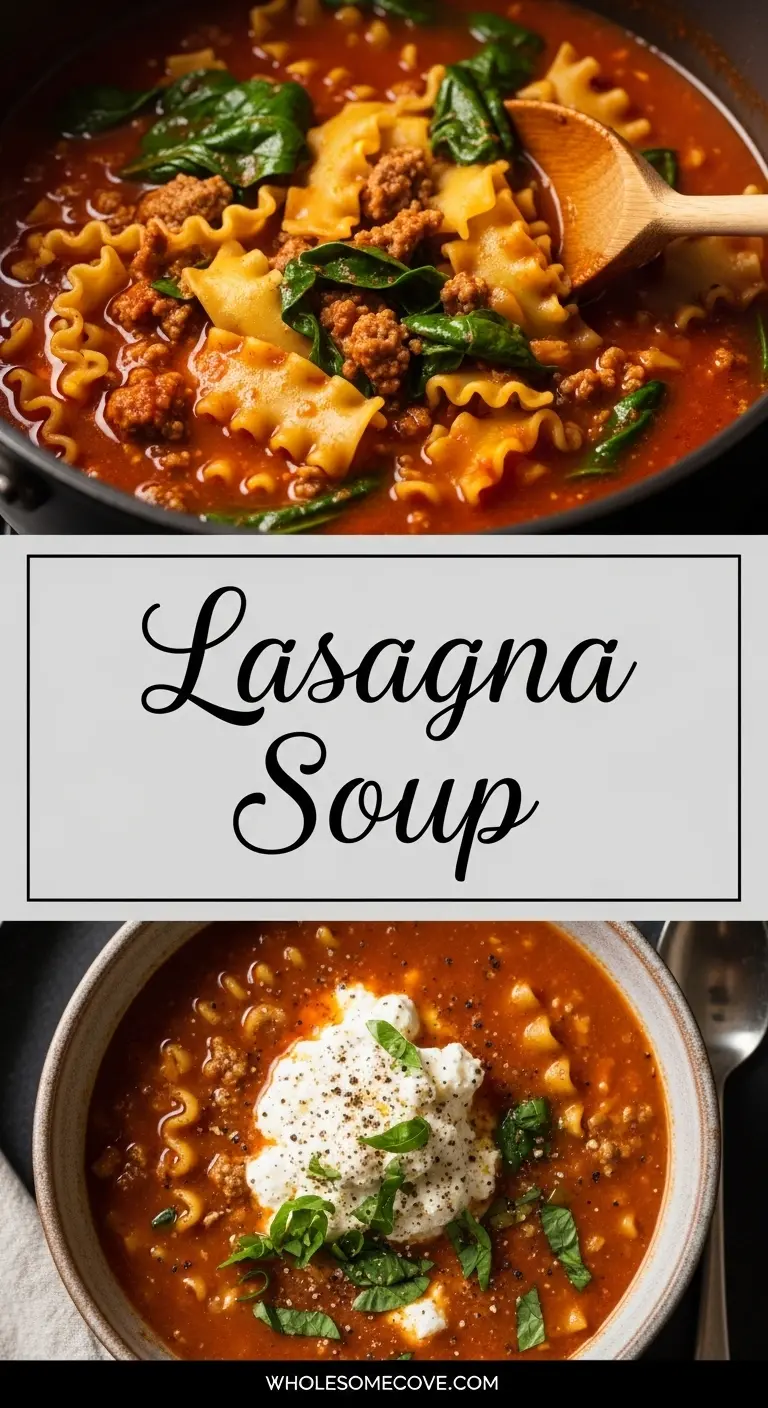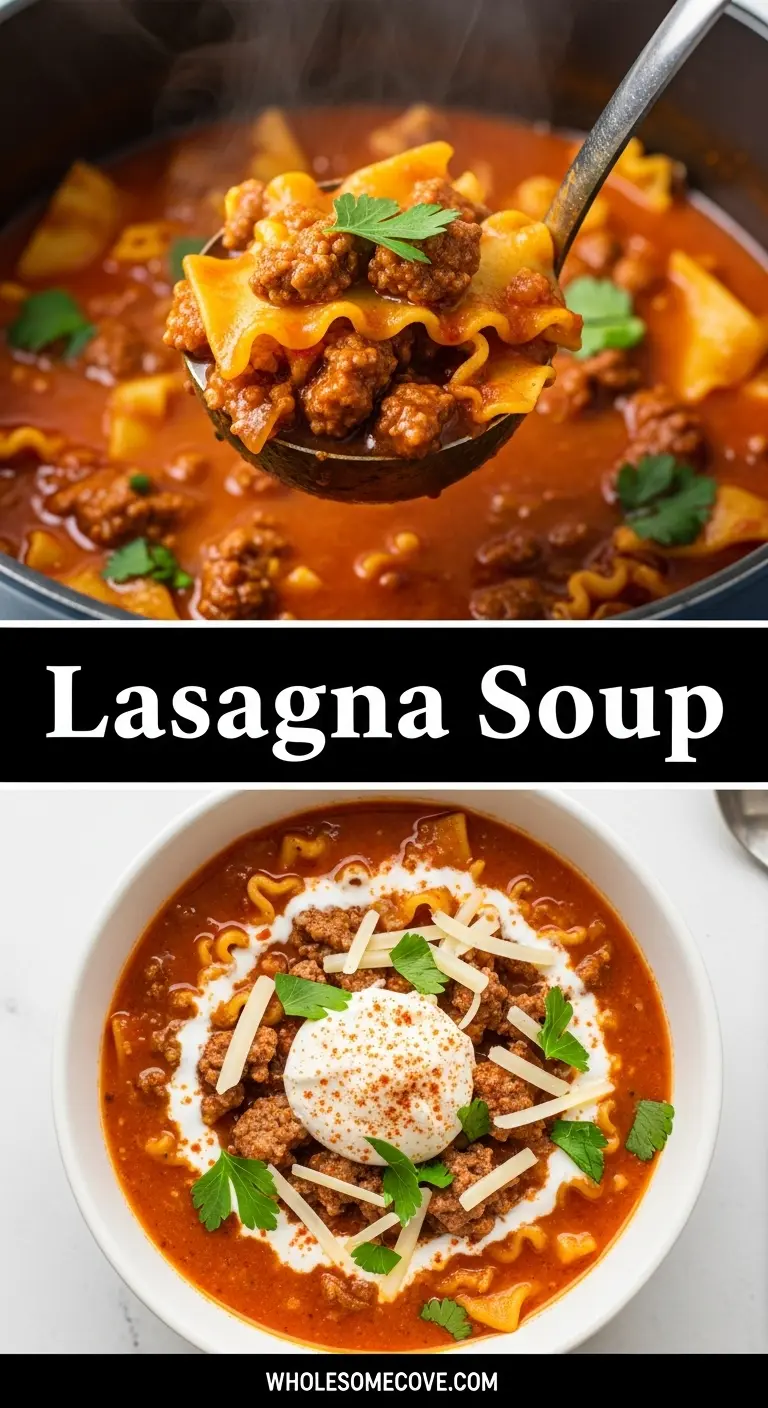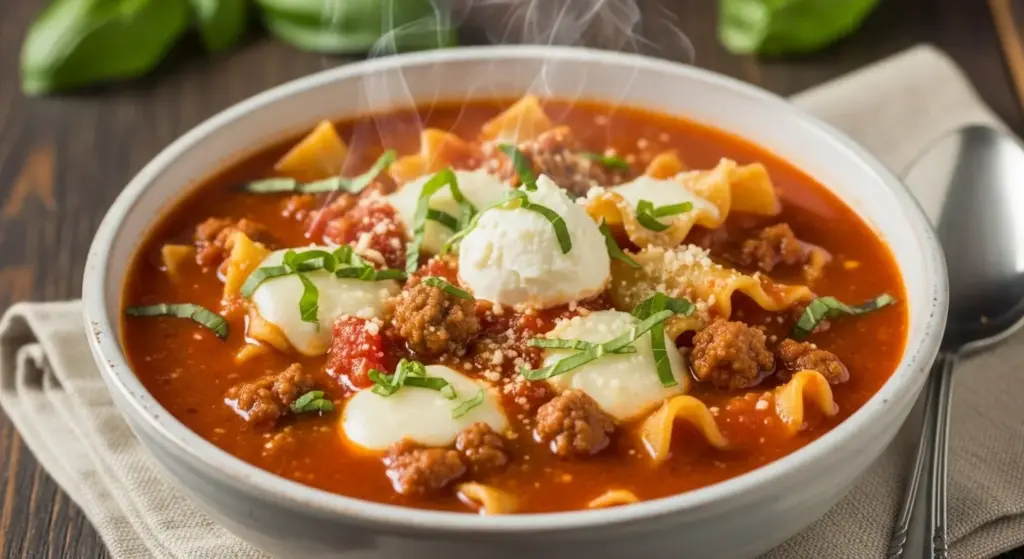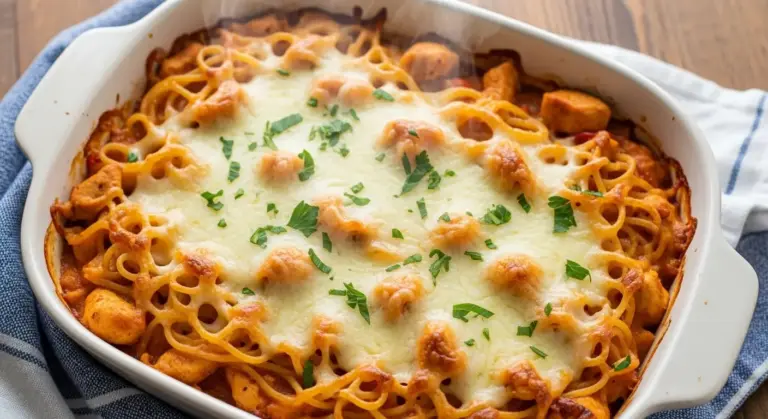I’ve been making lasagna for years, but it wasn’t until a particularly busy weeknight that I discovered the magic of turning this Italian classic into soup form.
My family was craving something hearty and comforting, but I didn’t have three hours to layer noodles and cheese into a baking dish. That’s when I threw together what would become our household’s most-requested meal: lasagna soup recipe that captures every bit of that rich, cheesy goodness in half the time.
The best part? You get all those familiar flavors—the rich tomato sauce, the creamy ricotta, the melted mozzarella—without all the fussy layering and long baking time. Just one pot, about 45 minutes, and you’re sitting down to a bowl of pure comfort.
| Quick Recipe Summary | |
|---|---|
| Prep Time | 15 minutes |
| Cook Time | 30 minutes |
| Total Time | 45 minutes |
| Servings | 6-8 bowls |
| Difficulty Level | Easy |

Why You’ll Love This Lasagna Soup Recipe
This soup has completely changed how my family thinks about weeknight dinners. It delivers all the satisfaction of traditional lasagna without the time commitment or the mountain of dishes.
The broth is rich and tomatoey with just the right amount of Italian seasoning. Every spoonful gives you tender pasta, savory meat, and those signature cheese dollops that make lasagna so irresistible.
I love that I can have this on the table in under an hour, which means I can serve lasagna flavors on a Tuesday without feeling overwhelmed. My kids actually ask for this version more often than the traditional baked one now.
Here’s what makes this recipe stand out:
- Quick and convenient: Ready in 45 minutes instead of hours
- One-pot wonder: Less cleanup means more time enjoying your meal
- All the classic flavors: You won’t miss a single element of traditional lasagna
- Easily customizable: Swap proteins, add vegetables, or adjust the cheese to your liking
- Perfect for meal prep: Tastes even better the next day and freezes beautifully
- Family-friendly: Even picky eaters go back for seconds
- Crowd-pleaser: Great for potlucks or feeding a group without stress
Another favorite soup option: Best Sausage Tortellini Soup
Ingredients
This lasagna soup comes together with ingredients you probably already have in your pantry and fridge. I’ve tweaked the ratios over dozens of batches to get the perfect balance of broth, pasta, and toppings.
The key is using good-quality Italian sausage and plenty of fresh herbs to really drive home those authentic Italian flavors.
- 1 lb (450g) Italian sausage (mild or hot, depending on your preference)
- 1 lb (450g) ground beef (85/15 works great for flavor and texture)
- 1 medium yellow onion, diced (about 1 cup/150g)
- 4 cloves garlic, minced
- 1 can (28 oz/794g) crushed tomatoes
- 1 can (15 oz/425g) tomato sauce
- 4 cups (960ml) beef broth (or chicken broth)
- 2 cups (480ml) water
- 2 tablespoons tomato paste
- 2 teaspoons dried basil
- 2 teaspoons dried oregano
- 1 teaspoon dried thyme
- 1 teaspoon sugar (balances the acidity)
- 1/2 teaspoon red pepper flakes (optional, for heat)
- 2 bay leaves
- Salt and black pepper to taste
- 8 oz (225g) lasagna noodles, broken into pieces (or use mini lasagna noodles)
- 2 tablespoons olive oil
For the Cheese Topping:
- 1 cup (250g) whole milk ricotta cheese
- 1 1/2 cups (170g) shredded mozzarella cheese
- 1/2 cup (50g) grated Parmesan cheese
- Fresh basil leaves for garnish
- Fresh parsley, chopped for garnish
Kitchen Equipment Needed
Having the right tools makes this recipe even easier to pull off. I learned the hard way that a flimsy pot doesn’t distribute heat evenly and can lead to scorched tomato sauce on the bottom.
After that mishap, I invested in quality cookware and it’s made all the difference in achieving consistent results every time.
- Large Dutch oven or heavy-bottomed soup pot (at least 6-quart capacity)
- Wooden spoon or heat-resistant spatula for stirring
- Sharp knife and cutting board for prep work
- Measuring cups and spoons
- Ladle for serving
- Cheese grater if using block cheese
- Small mixing bowl for combining ricotta mixture
- Can opener
Recommended Products for This Recipe
After making this soup countless times, I’ve found a few products that genuinely make the process smoother and the results even better. These aren’t just nice-to-haves—they actually improve the final dish.
1. Le Creuset Enameled Cast Iron Dutch Oven
This pot changed my soup-making life completely. It distributes heat so evenly that you never get those burnt spots on the bottom where tomato sauce likes to stick, and it holds temperature beautifully for simmering. The heavy lid traps moisture perfectly, keeping your soup from reducing too quickly.
2. San Marzano DOP Certified Tomatoes
I know canned tomatoes might seem like a small detail, but authentic San Marzano tomatoes have a naturally sweet flavor and lower acidity that makes the soup taste like it’s been simmering for hours. Once I switched to these, I noticed the difference immediately—no bitterness, just pure tomato goodness.
3. BelGioioso Ricotta con Latte Whole Milk Ricotta
Not all ricotta is created equal, and this one is incredibly creamy without being watery. It holds its shape when you dollop it into the hot soup and adds that authentic Italian richness you want. The texture is so much better than generic grocery store brands.
4. Microplane Premium Zester Grater
For the Parmesan cheese, freshly grated makes such a difference compared to the pre-shredded stuff. This grater creates light, fluffy shreds that melt instantly into the soup and on top of your cheese dollop. It’s also perfect for zesting citrus and grating garlic.
For more traditional Italian comfort, check out my Lasagna Recipe.

Step-by-Step Instructions: How to Make Lasagna Soup
I’ve broken down every step so you can nail this soup even if you’re a beginner. Take your time with the browning steps—that’s where a lot of the flavor develops.
1. Brown the Meat
- Heat the olive oil in your large Dutch oven or soup pot over medium-high heat until it shimmers slightly.
- Add the Italian sausage and ground beef to the pot, breaking it up with your wooden spoon into small, bite-sized crumbles.
- Cook for 8-10 minutes, stirring occasionally, until the meat is browned on all sides and no pink remains.
- Use your spoon to break up any large chunks—you want relatively uniform pieces that will distribute well throughout the soup.
- If there’s excessive grease (more than 2 tablespoons), drain most of it off, leaving just enough to coat the bottom of the pot for flavor.
2. Sauté the Aromatics
- Add the diced onion to the pot with the browned meat.
- Cook for 4-5 minutes, stirring frequently, until the onion becomes translucent and softens.
- Add the minced garlic and cook for another 60-90 seconds, stirring constantly so it doesn’t burn.
- You’ll know it’s ready when you can smell that beautiful garlic aroma filling your kitchen.
3. Build the Soup Base
- Stir in the tomato paste and cook for 1-2 minutes, letting it darken slightly and become fragrant—this step removes any metallic taste and concentrates the tomato flavor.
- Pour in the crushed tomatoes, tomato sauce, beef broth, and water.
- Add the dried basil, oregano, thyme, sugar, red pepper flakes (if using), and bay leaves.
- Season with 1 teaspoon of salt and 1/2 teaspoon of black pepper to start—you can adjust later.
- Stir everything together thoroughly, scraping up any browned bits from the bottom of the pot (that’s pure flavor).
4. Simmer the Soup
- Bring the soup to a boil over medium-high heat, which should take about 5-7 minutes.
- Once boiling, reduce the heat to medium-low to maintain a gentle simmer.
- Let it simmer uncovered for 15-20 minutes, stirring occasionally, so the flavors can meld together and the soup develops that rich, complex taste.
- If your soup seems too thick, add more water or broth 1/2 cup at a time until you reach your desired consistency.
This pairs beautifully with my Marinara Sauce Recipe if you want to make extra sauce for dipping garlic bread.
5. Cook the Pasta
- Break the lasagna noodles into roughly 2-inch pieces—don’t worry about making them perfect, rustic is fine.
- Add the broken noodles to the simmering soup and stir well to prevent them from clumping together.
- Continue simmering for 10-12 minutes, stirring every 2-3 minutes, until the noodles are tender but still have a slight bite (al dente).
- The noodles will continue to soften even after you remove the pot from heat, so don’t overcook them.
- Remove the bay leaves and discard them.
6. Prepare the Cheese Topping
- While the pasta is cooking, combine the ricotta cheese with 1/2 cup of the shredded mozzarella and 1/4 cup of the Parmesan in a small bowl.
- Mix gently with a fork or spoon until just combined—you want it to stay thick and creamy, not whipped.
- Season with a small pinch of salt and black pepper.
7. Serve and Garnish
- Taste the soup and adjust the seasoning with additional salt and pepper if needed.
- Ladle the hot soup into individual bowls, making sure each serving gets plenty of meat, noodles, and broth.
- Add a generous dollop (about 2-3 tablespoons) of the ricotta mixture to the center of each bowl.
- Sprinkle the remaining shredded mozzarella and Parmesan over the top of each bowl.
- Tear or chiffonade fresh basil leaves and sprinkle them over the cheese along with chopped fresh parsley for a pop of color and fresh flavor.
- Serve immediately while the soup is steaming hot and the cheese is starting to melt.

Tips for The Best Lasagna Soup
These tips come from trial and error over many batches. Some I learned from my own mistakes, others from feedback from family and friends who’ve made this recipe.
Pay special attention to the pasta cooking time—that’s where most people run into trouble.
- Don’t overcook the pasta: Lasagna noodles will continue to absorb liquid as the soup sits, so cook them just until al dente. If you’re making this ahead, undercook them slightly or add the pasta just before serving.
- Use quality Italian sausage: The flavor of your sausage makes a huge difference. Look for sausage with visible herbs and spices, and don’t be afraid to mix mild and hot for a balanced kick.
- Brown the meat properly: Take the time to get a good sear on your meat. Those browned bits add depth and richness that you can’t replicate any other way.
- Layer your seasoning: Season at multiple stages—when browning meat, after adding vegetables, and again at the end. This builds complex flavor rather than just adding salt at the end.
- Adjust thickness to preference: If you like thicker soup, use less water or let it simmer longer uncovered. For a brothier soup, add more liquid as needed.
- Make the cheese topping fresh: Don’t skip mixing the ricotta with mozzarella and Parmesan. This combination melts beautifully and gives you that authentic lasagna experience.
- Save some pasta water: If your soup gets too thick, the starchy pasta cooking liquid is perfect for thinning it back out while adding body.
- Let flavors develop: This soup tastes even better the next day after the flavors have had time to meld, so don’t be afraid to make it ahead.
- Garnish generously: Fresh herbs on top aren’t just for looks—they add brightness that balances the rich, heavy flavors.
- Serve with crusty bread: A good Italian bread or garlic bread is essential for soaking up every last drop of that delicious broth.
Read Also: Creamy Tomato Basil Soup Recipe
Serving Suggestions

This lasagna soup is hearty enough to stand alone as a complete meal, but pairing it with the right sides takes it from great to unforgettable. I love building a full Italian spread when I’m serving this to guests.
The soup is rich and filling, so I tend to choose lighter, fresher accompaniments that provide textural contrast.
Here are my favorite ways to serve it:
- Garlic bread or garlic knots: Warm, buttery bread is non-negotiable. Use it to sop up every bit of that amazing broth.
- Simple green salad: A crisp salad with mixed greens, cherry tomatoes, red onion, and a light vinaigrette cuts through the richness perfectly.
- Caesar salad: For a more substantial side, the creamy dressing and crunchy croutons complement the soup beautifully.
- Roasted vegetables: Try Roasted Brussels Sprouts with Bacon or Maple Glazed Carrots for a seasonal touch.
- Bruschetta: Fresh tomato bruschetta adds brightness and another hit of that tomato-basil flavor profile.
- Antipasto platter: Olives, cured meats, marinated vegetables, and cheese make a festive starter.
- Italian breadsticks: Crunchy grissini are perfect for dunking and add a nice textural element.
- Caprese salad: Fresh mozzarella, tomatoes, and basil echo the flavors in the soup while keeping things light.
You might also enjoy: Beef Barley Soup
Variations of Lasagna Soup
One of my favorite things about this recipe is how adaptable it is. I’ve made countless variations depending on what’s in my fridge, dietary needs, or just what I’m craving that day.
Each version brings something different to the table while maintaining that essential lasagna character.
- Vegetarian lasagna soup: Omit the meat and add 2 cups of chopped mushrooms, 1 diced zucchini, and 1 diced bell pepper. You can also add a can of white beans for protein and heartiness.
- Spicy lasagna soup: Use all hot Italian sausage, double the red pepper flakes, and add a diced jalapeño with the onions. Top with a drizzle of hot honey for a sweet-heat finish.
- White lasagna soup: Replace the tomatoes with heavy cream and chicken broth for a creamy, Alfredo-style version. Add spinach and use chicken instead of beef and sausage.
- Turkey lasagna soup: Swap the beef and sausage for ground turkey or turkey sausage for a leaner option that’s still packed with flavor.
- Keto-friendly version: Replace the lasagna noodles with zucchini noodles or cabbage strips added during the last 5 minutes of cooking.
- Slow cooker method: Brown the meat and sauté the aromatics, then transfer everything except the pasta and cheese to a slow cooker. Cook on low for 6-8 hours, add the pasta 30 minutes before serving.
- Extra cheesy: Stir 1/2 cup of cream cheese into the soup base for ultra-creamy richness, or add a rind of Parmesan cheese while simmering for extra depth.
- Add vegetables: Throw in chopped spinach, kale, or Swiss chard during the last 5 minutes of cooking for added nutrition and color.
- Seafood version: Replace meat with shrimp and use fish or vegetable broth as the base for a unique twist.
- Mexican-inspired: Add cumin, chili powder, and a can of green chiles. Top with pepper jack cheese and cilantro instead of the Italian herbs and cheeses.
For a heartier variation, try my Slow Cooker Chili Recipe.
Storage and Reheating
Lasagna soup is one of those rare dishes that actually improves after sitting in the fridge overnight. The flavors deepen and meld together in the most delicious way.
I always make a big batch specifically so we can enjoy leftovers throughout the week.
- Refrigerator storage: Let the soup cool to room temperature, then transfer to an airtight container. Store in the refrigerator for up to 4 days. Keep the ricotta topping separate in its own container if possible—it stays fresher that way.
- Freezer storage: This soup freezes beautifully for up to 3 months. I recommend freezing it in individual portions for easy weeknight meals. Cool completely, then transfer to freezer-safe containers or heavy-duty freezer bags, leaving about an inch of space at the top for expansion. Don’t freeze the ricotta topping—make it fresh when you’re ready to serve.
- Reheating on the stovetop: Transfer the soup to a pot and reheat over medium-low heat, stirring occasionally, until heated through (about 10-15 minutes). You’ll likely need to add 1/2 to 1 cup of water or broth as the pasta will have absorbed a lot of liquid. Stir frequently to prevent sticking.
- Reheating in the microwave: Place individual portions in microwave-safe bowls and heat in 2-minute intervals, stirring between each interval, until steaming hot. Add a splash of water or broth if needed to loosen it up.
- From frozen: Thaw overnight in the refrigerator for best results, then reheat using either method above. If you’re in a rush, you can reheat from frozen on the stovetop over low heat with a lid on, adding extra liquid as needed and stirring frequently—it just takes longer (about 25-30 minutes).
- Reviving leftovers: Leftover soup often thickens considerably. Thin it out with broth or water, and taste and adjust seasonings as needed—sometimes it needs a little extra salt or a splash of acid (lemon juice or red wine vinegar) to brighten it back up.
- The pasta situation: If you know you’ll have leftovers, consider cooking the pasta separately and adding it to individual bowls as you serve. The pasta won’t get mushy, and your soup will last longer in the fridge.
Another favorite for meal prep: Lentil and Vegetable Soup
Nutritional Facts
This hearty lasagna soup is filling and satisfying, with a good balance of protein, carbohydrates, and fats. Keep in mind that these numbers are approximate and can vary based on specific ingredients and portion sizes.
Per Serving (1 bowl, based on 8 servings):
- Calories: 425
- Total Fat: 22g
- Saturated Fat: 9g
- Cholesterol: 75mg
- Sodium: 890mg
- Total Carbohydrates: 32g
- Dietary Fiber: 4g
- Sugars: 8g
- Protein: 28g
- Calcium: 285mg
- Iron: 4mg
- Potassium: 720mg
The soup provides a substantial amount of protein from the meat and cheese, making it a satisfying meal that will keep you full for hours. The tomatoes contribute vitamin C and lycopene, while the herbs add antioxidants.
If you’re watching your sodium intake, you can reduce the salt and use low-sodium broth. To lighten it up, use lean ground turkey and turkey sausage, reduce the cheese, or serve smaller portions with a large side salad.
Health Benefits of Key Ingredients
Beyond being absolutely delicious, lasagna soup actually packs some impressive nutritional benefits. I love that I can serve my family something that tastes indulgent but still provides real nourishment.
Here’s what makes this soup more than just comfort food:
- Tomatoes: Rich in lycopene, a powerful antioxidant that’s been linked to reduced risk of heart disease and certain cancers. Cooking tomatoes actually increases the bioavailability of lycopene, making this soup even more beneficial. They’re also high in vitamins C and K, potassium, and folate.
- Garlic: Contains compounds like allicin that have anti-inflammatory and immune-boosting properties. Garlic has been shown to help lower blood pressure and cholesterol levels, and it adds incredible flavor without sodium.
- Onions: Packed with antioxidants and compounds that may help reduce inflammation and cholesterol levels. They’re also a good source of vitamin C and fiber, supporting immune health and digestion.
- Basil and oregano: These herbs aren’t just for flavor—they’re loaded with antioxidants and have antibacterial properties. Basil contains flavonoids that protect cells, while oregano has one of the highest antioxidant activity ratings among herbs.
- Olive oil: A healthy fat source rich in monounsaturated fatty acids and antioxidants. It supports heart health, reduces inflammation, and helps your body absorb the fat-soluble vitamins in the vegetables.
- Ricotta cheese: Provides calcium for strong bones and teeth, plus protein for muscle maintenance. It’s also a good source of vitamin A, which supports eye health and immune function.
- Ground beef: Supplies high-quality protein, iron (important for energy and oxygen transport), zinc (supports immune function), and B vitamins (especially B12 for nerve health).
- Italian sausage: While higher in fat, it provides protein and flavor that makes the dish satisfying, which can help with portion control and preventing overeating later.
Read Also: Easy Healthy Dinner Recipes for Family

FAQs About Lasagna Soup
1. Can I use different types of pasta?
Absolutely! While broken lasagna noodles give you that authentic lasagna experience, you can substitute with any pasta shape you have on hand. Rotini, penne, farfalle, or even egg noodles work great—just adjust the cooking time according to the package directions. I’ve even used frozen ravioli in a pinch, which adds an extra layer of cheesy goodness.
2. How do I keep the noodles from getting mushy?
The key is cooking them just until al dente and serving the soup promptly. If you’re meal prepping or know you’ll have leftovers, I highly recommend cooking the pasta separately and adding it to individual bowls as you serve. This way, the noodles don’t sit in the broth absorbing liquid and getting soft.
3. Can I make this soup in a slow cooker?
Yes, and it’s perfect for busy days! Brown the meat and sauté the onions and garlic in a skillet first, then transfer everything except the pasta and cheese to your slow cooker. Add all the liquids and seasonings, then cook on low for 6-8 hours or high for 3-4 hours. Add the pasta during the last 30 minutes on high heat so it doesn’t overcook.
4. What’s the best way to serve this for a crowd?
Set up a lasagna soup bar! Keep the soup warm in a slow cooker set to the “warm” setting, and arrange bowls of the ricotta mixture, shredded mozzarella, Parmesan, fresh herbs, red pepper flakes, and garlic bread on the side. Guests can customize their bowls to their liking, and it’s a fun, interactive way to serve dinner.
5. Why is my soup too thin or too thick?
Soup thickness is easy to adjust! If it’s too thin, let it simmer uncovered for 10-15 minutes to reduce the liquid, or add a slurry of 1 tablespoon cornstarch mixed with 2 tablespoons cold water. If it’s too thick, simply add more broth or water 1/2 cup at a time until you reach your desired consistency. Remember that the pasta will continue absorbing liquid as the soup sits, so it naturally thickens over time.
For another comforting pasta dish, try my Pumpkin Sage Pasta.
Final Thoughts
This lasagna soup has earned its permanent spot in my dinner rotation, and I hope it finds a place in yours too. It brings all the cozy, comforting feelings of traditional lasagna without the hassle, making it perfect for those nights when you want something special but don’t have hours to spend in the kitchen.
I love how forgiving this recipe is—you can adjust seasonings, swap ingredients, and make it your own while still getting that incredible Italian comfort food experience. The best part might be watching your family’s faces light up when they take that first bite and realize they’re eating lasagna in a bowl.
Give this lasagna soup a try and let me know how it turns out! I’d love to hear about any variations you create or how your family enjoys it. Drop a comment below with your experience, and don’t forget to share this recipe with friends who need more cozy comfort food in their lives.
Recommended:
- Velveeta Mac and Cheese Recipe
- Best Bacon Mac and Cheese Recipe
- Easy Chicken Noodle Soup Recipe
- Instant Pot Chicken Noodle Soup Recipe
- Butternut Squash Gnocchi Recipe
- Meatloaf Recipe
- Air Fryer Lasagna Recipe
- Sloppy Joe Recipe
- Marry Me Chicken Soup Recipe
- Panera Broccoli Cheddar Soup Recipe




